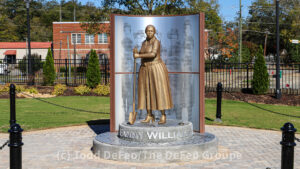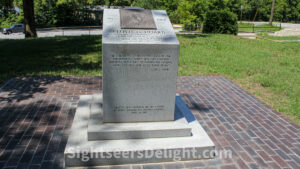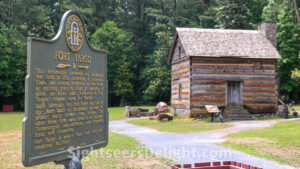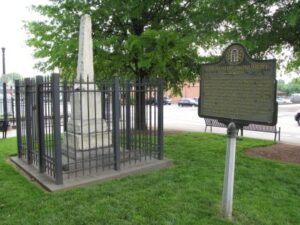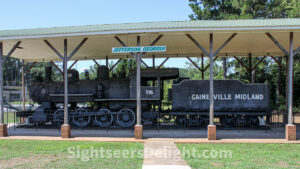A Coca-Cola syrup salesman named James Couden painted a sign advertising the soda on the side of Young Brothers Pharmacy (known as Young Bros Drug Company at the time). It turns out he made history with his work of art as this was the first Coca-Cola painted wall sign in the world. The pharmacy celebrates the advertisement with a display of Coke memorabilia and collectibles. Interestingly, the Coca-Cola Co. regularly repainted the sign until the late 1970s, but underneath all those paint jobs was the original sign, which was restored in 1989.
30120
Floyd G. Hoard was the solicitor general of the Piedmont Judicial Circuit when he was killed on August 7, 1967, by a car bomb. He was known for aggressively prosecuting organized crime in the area. Local citizens dedicated the monument on the Historic Jackson County Courthouse grounds on April 19, 1997.
30549
James Oglethorpe established Fort Frederica on what is today St. Simons Island in 1736, just three years after he founded Georgia.. The goal of the settlement was to to protect the southern boundary of the British colony of Georgia from the Spanish. At times, more than 600 British troops were stationed at the fort. A visitor to the fort in 1745 described it as “a pretty strong fort of tabby,” noting the structure was “surrounded by a quadrangular rampart, with four bastions of earth well stocked and turned, and a palisade ditch.” During the battles of Bloody Marsh and Gully Hole Creek in 1742, Oglethorpe’s successfully repulsed Spanish attempts to invade St. Simons Island.
31522
Built in 1721, a dozen years before the first city in Georgia, Savannah, was founded, Fort King George was both the first English settlement on Georgia’s coast and the British Empire’s southernmost outpost in North America. It remained the southernmost settlement until 1736 when Fort Frederica was built on what is today St. Simon’s Island. With the help of historic drawings, the Lower Altamaha Historical Society and the Georgia Department of Natural Resources in 1988, a number of the fort’s structures were rebuilt, including the cypress blockhouse. The reconstructed fort is a replica of Barnwell’s original construction. Today, the park highlights the area’s 18th century cultural history, including the Guale Indians, the 17th century Spanish mission Santo Domingo de Talaje, Fort King George and the Scottish colonists. In addition, the state park features information about 19th century sawmilling.
31305
The first European settlers came to the area in the late 1700s and built a series of forts, including Fort Yargo, to protect themselves from the natives. The 260-acre Fort Yargo State Park is home to a long fort was built in 1792 or 1793. The structure may have been built at the request of the Creek Indians who were then at war with the Cherokees. The Creeks likely were the first Indians to arrive in the area of what is now Barrow County and created the village of Snodon in what is now downtown Winder.
30680
When Mark Anthony Cooper found himself $100,000 in debt in 1857 and his company, the Etowah Iron and Manufacturing Co., was about to be auctioned, he turned to his friends for help. With the help of 38 friends, Cooper raised $200,000 and purchased back his company. But, he didn’t forget his friends, and in 1860, after he repaid the debt, Cooper built a monument to thank them. The monument was originally erected on the town square of Etowah where his iron company was located. In 1864, the monument survived the wrath of Union soldiers led by Gen. William T. Sherman. In 1927, as the federal government was poised to create Lake Allatoona, the monument was relocated to nearby Cartersville. Three decades later, the monument was moved to the banks of Lake Allatoona to make room for more parking spaces in downtown Cartersville. In 1999, the monument moved to its current location in downtown Cartersville and the aptly renamed Friendship Plaza.
Philadelphia-based Baldwin Locomotive Works built Gainesville Midland No. 116, which sits in Jefferson, Georgia, as a memorial to the Gainesville Midland Railroad. The Gainesville Midland bought the class C-3 2-8-0 locomotive from the Central of Georgia Railway, which ordered it in about 1906. The Gainesville Midland used the steamer until its retirement in 1958 following a crack in its boiler. The locomotive is on display outside of Jefferson High School. The railroad donated it to the city in 1959.
The Georgia Capitol Museum traces its origins to 1889 when the Georgia General Assembly revived the office of state geologist and directed him “to collect, analyze, and classify specimens of minerals, plants and soils.” The following year, the governor designated the corridors of the fourth floor of the Capitol as temporary quarters to house the museum.
30334
IN JULY 2022, A VANDAL DESTROYED THE GEORGIA GUIDESTONES.
Since first unveiled in March 1980, the Georgia Guidestones have confounded and intrigued tourists. An anonymous benefactor, using the name R.C. Christian, showed up in Elbert County in 1979 to build the monument. According to sources, Christian was working on behalf of an anonymous group. The 19-foot-tall monument, comprised of six granite stones, sits along Georgia Highway 77 on one of the highest tracts of land in Elbert County. The monument, known as “America’s Stonehenge,” was built using granite from Elbertson, the “Granite Capital of the World.”
30635

